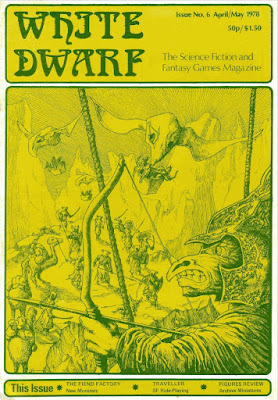White Dwarf: Issue #6
 Issue #6 of White Dwarf (April/May 1978) features a cover by Chris Beaumont. Looking at Beaumont's piece, I finally realized how much I like these early WD covers – not so much for the art in all cases but for the use of a single background color, which I find very striking. Apparently, I needed reminding that I prefer simple, amateurish covers like those of older gaming products. Speaking of the past, I note Ian Livingstone's editorial, in which he boasts of the fact that, starting with this issue, the text is now right justified. It's easy to laugh at this from the vantage point of the 21st century, but, in 1978, this would have been a genuinely big deal, especially for a amateur/semi-pro magazine like White Dwarf.
Issue #6 of White Dwarf (April/May 1978) features a cover by Chris Beaumont. Looking at Beaumont's piece, I finally realized how much I like these early WD covers – not so much for the art in all cases but for the use of a single background color, which I find very striking. Apparently, I needed reminding that I prefer simple, amateurish covers like those of older gaming products. Speaking of the past, I note Ian Livingstone's editorial, in which he boasts of the fact that, starting with this issue, the text is now right justified. It's easy to laugh at this from the vantage point of the 21st century, but, in 1978, this would have been a genuinely big deal, especially for a amateur/semi-pro magazine like White Dwarf."Combat and Armour Class" by Roger Musson is a lengthy examination of the concept of AC in Dungeons & Dragons and proposes various options and house rules to it. Many of the options should be familiar with longstanding players of D&D, such as making it viable for fighters to go largely or lightly unarmored like the heroes of pulp fantasy. More interesting (to me anyway) is Musson's proposal of a series of death saving throws when a character drops below 0 hit points. This approach or something similar to it has become quite widespread in recent years, but Musson came up with this idea in 1978.
"The Fiend Factory" is a collection of seven new monsters for use with D&D. The monsters, created by Ian Livingstone, Roger Musson, and Trevor Graver, are (mostly) familiar to anyone who's made use of the Fiend Folio. "Archive Miniatures" by John Norris is a review of the aforesaid miniatures, of which Norris thinks very highly. Meanwhile, Lewis Pulsipher offers "A Place in the Wilderness," a short article that provides D&D game statistics for creatures derived from Jack Vance's novel, The Dragon Masters. "Open Box" provides reviews of Knights of the Round Table (Little Soldier), Elric (Chaosium), Wilderlands of High Fantasy (Judges Guild), Dungeon Decor and Labyrinthine (both by Falchion Products), and The Endless Dungeon (Wee Warriors). With only a couple of exceptions, I'd never heard of most of these products – but then there have been so many wargaming and RPG products published in the last half-century, that's far from surprising.
Also reviewed is GDW's Traveller, in this case by Don Turnbull in a three-page article that covers every aspect of the game. By and large, Turnbull is favorably impressed by the game. However, he points out two things he considers serious omissions. First, Turnbull wishes there were more examples of pre-generated material for use by the referee. In this, he compares Traveller unfavorably to Metamorphosis Alpha, which is, frankly, a strange thing to do. Nevertheless, I can see his point, at least broadly. Second, Turnbull points out that there are no rules for creating or playing nonhuman aliens. That's a fair point, though I would counter that Traveller was largely inspired by the humanocentric science fiction of the decades immediately following the Second World War and thus it makes sense that
There's another installment of David Lloyd's "Kalgar" comic, as well as some magic items for D&D by Duncan Campbell. Martin Easterbrook provides yet another "Hit Location in Melee" article. It's not a terrible system, as it goes, but I'm generally of the mind that D&D's inflationary hit points system isn't really compatible with a more "realistic" approach to hit location. The philosophy behind the two approaches are very different and it'd be better to stick with either D&D's approach or, say, that of RuneQuest rather than trying to hybridize them. Brian Asbury continues to detail his alternate experience point system, this time with awards for spellcasting based on the character level and the spell level. While I understand the logic behind such awards – I've been hearing defenses of it my whole time as a roleplayer – I've never been a fan. Asbury's system seems skewed toward providing more XP to lower-level casters and, again, I understand the logic behind it, but it does little to convince me of the value of adopting his overall approach.
And, with that, we're done another issue of White Dwarf. What strikes me most about this issue is the way it highlights that the first few years after the release of Dungeons & Dragons were filled reckless experimentation with the game's rules. House rules, variants, and options abound, many of them not at all to my taste. Nevertheless, it's good to see the extent to which the earliest players and referees saw scope for adding to – or "improving" in their eyes – D&D. This is at the heart of why I think roleplaying games are such remarkable pastimes: they encourage creative engagement with them in a way that boardgames and video games rarely do (cue howls to then contrary in the comments). So, while this is far from my favorite issue of White Dwarf thus far, I nevertheless found it satisfying and look forward to what is coming in the future.
James Maliszewski's Blog
- James Maliszewski's profile
- 3 followers



